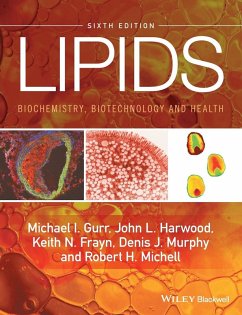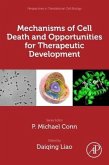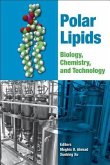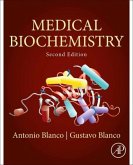Michael I. Gurr, John L. Harwood (Cardiff University), Keith N. Frayn (University of Oxford)
Lipids
Biochemistry, Biotechnology and Health
Michael I. Gurr, John L. Harwood (Cardiff University), Keith N. Frayn (University of Oxford)
Lipids
Biochemistry, Biotechnology and Health
- Broschiertes Buch
- Merkliste
- Auf die Merkliste
- Bewerten Bewerten
- Teilen
- Produkt teilen
- Produkterinnerung
- Produkterinnerung
For the 6th Edition of this highly regarded textbook devoted to lipids, the title has been modified from Lipid Biochemistry to Lipids to acknowledge the coming together of biological and medical sciences, the increasingly blurred boundaries between them and the growing importance of lipids in diverse aspects of science and technology.
Andere Kunden interessierten sich auch für
![Mechanisms of Cell Death and Opportunities for Therapeutic Development Mechanisms of Cell Death and Opportunities for Therapeutic Development]() Mechanisms of Cell Death and Opportunities for Therapeutic Development113,99 €
Mechanisms of Cell Death and Opportunities for Therapeutic Development113,99 €![Quantum Mechanics, Cell-Cell Signaling, and Evolution Quantum Mechanics, Cell-Cell Signaling, and Evolution]() John S. TordayQuantum Mechanics, Cell-Cell Signaling, and Evolution124,99 €
John S. TordayQuantum Mechanics, Cell-Cell Signaling, and Evolution124,99 €![Polar Lipids Polar Lipids]() Polar Lipids101,99 €
Polar Lipids101,99 €![Sterol Regulation of Ion Channels Sterol Regulation of Ion Channels]() Sterol Regulation of Ion Channels126,99 €
Sterol Regulation of Ion Channels126,99 €![Lipidomics and Bioactive Lipids: Lipids and Cell Signaling Lipidomics and Bioactive Lipids: Lipids and Cell Signaling]() H. Alex Brown (Volume ed.)Lipidomics and Bioactive Lipids: Lipids and Cell Signaling146,99 €
H. Alex Brown (Volume ed.)Lipidomics and Bioactive Lipids: Lipids and Cell Signaling146,99 €![Chemical and Functional Properties of Food Components Chemical and Functional Properties of Food Components]() Chemical and Functional Properties of Food Components207,99 €
Chemical and Functional Properties of Food Components207,99 €![Medical Biochemistry Medical Biochemistry]() Antonio BlancoMedical Biochemistry125,99 €
Antonio BlancoMedical Biochemistry125,99 €-
-
-
For the 6th Edition of this highly regarded textbook devoted to lipids, the title has been modified from Lipid Biochemistry to Lipids to acknowledge the coming together of biological and medical sciences, the increasingly blurred boundaries between them and the growing importance of lipids in diverse aspects of science and technology.
Produktdetails
- Produktdetails
- Verlag: John Wiley and Sons Ltd
- 6 ed
- Seitenzahl: 448
- Erscheinungstermin: 26. August 2016
- Englisch
- Abmessung: 246mm x 189mm x 24mm
- Gewicht: 940g
- ISBN-13: 9781118501139
- ISBN-10: 1118501136
- Artikelnr.: 44505114
- Herstellerkennzeichnung
- Libri GmbH
- Europaallee 1
- 36244 Bad Hersfeld
- gpsr@libri.de
- Verlag: John Wiley and Sons Ltd
- 6 ed
- Seitenzahl: 448
- Erscheinungstermin: 26. August 2016
- Englisch
- Abmessung: 246mm x 189mm x 24mm
- Gewicht: 940g
- ISBN-13: 9781118501139
- ISBN-10: 1118501136
- Artikelnr.: 44505114
- Herstellerkennzeichnung
- Libri GmbH
- Europaallee 1
- 36244 Bad Hersfeld
- gpsr@libri.de
Michael Gurr was Visiting Professor in Human Nutrition at Reading and Oxford Brookes Universities, UK. John Harwood is a Professor of Biochemistry, School of Biosciences, Cardiff University, UK. Keith Frayn is Emeritus Professor of Human Metabolism, University of Oxford, UK. Denis Murphy is Professor of Biotechnology, School of Applied Sciences, University of South Wales, UK. Robert Michell is Professor of Biochemistry, School of Biosciences, University of Birmingham, UK.
Preface xv
Acknowledgements xvii
About the authors xix
About the companion website xxi
1 Lipids: definitions naming methods and a guide to the contents of this
book 1
1.1 Introduction 1
1.2 Definitions 1
1.3 Structural chemistry and nomenclature 1
1.4 Lipidomics 4
1.5 A guide to the contents of this book 8
Key points 11
Further reading 12
2 Important biological lipids and their structures 13
2.1 Structure and properties of fatty acids 13
2.2 Storage lipids - triacylglycerols and wax esters 20
2.3 Membrane lipids 26
Key points 42
Further reading 42
3 Fatty acid metabolism 44
3.1 The biosynthesis of fatty acids 44
3.2 Degradation of fatty acids 85
3.3 Chemical peroxidation is an important reaction particularly of
polyunsaturated fatty acids 95
3.4 Peroxidation catalysed by lipoxygenase enzymes 96
3.5 Essential fatty acids and the biosynthesis of eicosanoids 100
Key points 120
Further reading 121
4 The metabolism of complex lipids 124
4.1 The biosynthesis of triacylglycerols 124
4.2 The catabolism of acylglycerols 133
4.3 The integration and control of animal acylglycerol metabolism 136
4.4 Wax esters 143
4.5 Phosphoglyceride biosynthesis 146
4.6 Degradation of phospholipids 157
4.7 Metabolism of glycosylglycerides 163
4.8 Metabolism of sphingolipids 165
4.9 Cholesterol biosynthesis 173
Key points 182
Further reading 183
5 Roles of lipids in cellular structures 187
5.1 Lipid assemblies 187
5.2 Role of lipids in cellular evolution 193
5.3 Membrane structure 201
5.4 Membrane function 206
5.5 Intracellular lipid droplets 215
5.6 Extracellular lipid assemblies 222
Key points 226
Further reading 227
6 Dietary lipids and their biological roles 229
6.1 Lipids in food 229
6.2 Roles of dietary lipids 233
Key points 251
Further reading 251
7 Lipid assimilation and transport 253
7.1 Lipid digestion and absorption 253
7.2 Transport of lipids in the blood: plasma lipoproteins 261
7.3 The coordination of lipid metabolism in the body 275
Key points 284
Further reading 285
8 Lipids in transmembrane signalling and cell regulation 287
8.1 Phosphoinositides have diverse roles in cell signalling and cell
compartmentation 288
8.2 Endocannabinoid signalling 299
8.3 Lysophosphatidate and sphingosine 1-phosphate in the circulation
regulate cell motility and proliferation 299
8.4 Signalling by phospholipase D at least partly through phosphatidate
300
8.5 Ceramide regulates apoptosis and other cell responses 301
Key points 302
Further reading 303
9 The storage of triacylglycerols in animals and plants 304
9.1 White adipose tissue depots and triacylglycerol storage in animals 304
9.2 Brown adipose tissue and its role in thermogenesis 310
9.3 Lipid storage in plants 313
Key points 314
Further reading 315
10 Lipids in health and disease 317
10.1 Inborn errors of lipid metabolism 317
10.2 Lipids and cancer 323
10.3 Lipids and immune function 328
10.4 Effects of too much or too little adipose tissue: obesity and
lipodystrophies 338
10.5 Disorders of lipoprotein metabolism 349
Key points 364
Further reading 365
11 Lipid technology and biotechnology 367
11.1 Introduction 367
11.2 Lipid technologies: from surfactants to biofuels 367
11.3 Lipids in foods 375
11.4 Modifiying lipids in foods 379
11.5 Modifying lipids in nonedible products 383
11.6 Lipids and genetically modified organisms 385
Key points 390
Further reading 390
Index and list of abbreviations 391
Acknowledgements xvii
About the authors xix
About the companion website xxi
1 Lipids: definitions naming methods and a guide to the contents of this
book 1
1.1 Introduction 1
1.2 Definitions 1
1.3 Structural chemistry and nomenclature 1
1.4 Lipidomics 4
1.5 A guide to the contents of this book 8
Key points 11
Further reading 12
2 Important biological lipids and their structures 13
2.1 Structure and properties of fatty acids 13
2.2 Storage lipids - triacylglycerols and wax esters 20
2.3 Membrane lipids 26
Key points 42
Further reading 42
3 Fatty acid metabolism 44
3.1 The biosynthesis of fatty acids 44
3.2 Degradation of fatty acids 85
3.3 Chemical peroxidation is an important reaction particularly of
polyunsaturated fatty acids 95
3.4 Peroxidation catalysed by lipoxygenase enzymes 96
3.5 Essential fatty acids and the biosynthesis of eicosanoids 100
Key points 120
Further reading 121
4 The metabolism of complex lipids 124
4.1 The biosynthesis of triacylglycerols 124
4.2 The catabolism of acylglycerols 133
4.3 The integration and control of animal acylglycerol metabolism 136
4.4 Wax esters 143
4.5 Phosphoglyceride biosynthesis 146
4.6 Degradation of phospholipids 157
4.7 Metabolism of glycosylglycerides 163
4.8 Metabolism of sphingolipids 165
4.9 Cholesterol biosynthesis 173
Key points 182
Further reading 183
5 Roles of lipids in cellular structures 187
5.1 Lipid assemblies 187
5.2 Role of lipids in cellular evolution 193
5.3 Membrane structure 201
5.4 Membrane function 206
5.5 Intracellular lipid droplets 215
5.6 Extracellular lipid assemblies 222
Key points 226
Further reading 227
6 Dietary lipids and their biological roles 229
6.1 Lipids in food 229
6.2 Roles of dietary lipids 233
Key points 251
Further reading 251
7 Lipid assimilation and transport 253
7.1 Lipid digestion and absorption 253
7.2 Transport of lipids in the blood: plasma lipoproteins 261
7.3 The coordination of lipid metabolism in the body 275
Key points 284
Further reading 285
8 Lipids in transmembrane signalling and cell regulation 287
8.1 Phosphoinositides have diverse roles in cell signalling and cell
compartmentation 288
8.2 Endocannabinoid signalling 299
8.3 Lysophosphatidate and sphingosine 1-phosphate in the circulation
regulate cell motility and proliferation 299
8.4 Signalling by phospholipase D at least partly through phosphatidate
300
8.5 Ceramide regulates apoptosis and other cell responses 301
Key points 302
Further reading 303
9 The storage of triacylglycerols in animals and plants 304
9.1 White adipose tissue depots and triacylglycerol storage in animals 304
9.2 Brown adipose tissue and its role in thermogenesis 310
9.3 Lipid storage in plants 313
Key points 314
Further reading 315
10 Lipids in health and disease 317
10.1 Inborn errors of lipid metabolism 317
10.2 Lipids and cancer 323
10.3 Lipids and immune function 328
10.4 Effects of too much or too little adipose tissue: obesity and
lipodystrophies 338
10.5 Disorders of lipoprotein metabolism 349
Key points 364
Further reading 365
11 Lipid technology and biotechnology 367
11.1 Introduction 367
11.2 Lipid technologies: from surfactants to biofuels 367
11.3 Lipids in foods 375
11.4 Modifiying lipids in foods 379
11.5 Modifying lipids in nonedible products 383
11.6 Lipids and genetically modified organisms 385
Key points 390
Further reading 390
Index and list of abbreviations 391
Preface xv
Acknowledgements xvii
About the authors xix
About the companion website xxi
1 Lipids: definitions naming methods and a guide to the contents of this
book 1
1.1 Introduction 1
1.2 Definitions 1
1.3 Structural chemistry and nomenclature 1
1.4 Lipidomics 4
1.5 A guide to the contents of this book 8
Key points 11
Further reading 12
2 Important biological lipids and their structures 13
2.1 Structure and properties of fatty acids 13
2.2 Storage lipids - triacylglycerols and wax esters 20
2.3 Membrane lipids 26
Key points 42
Further reading 42
3 Fatty acid metabolism 44
3.1 The biosynthesis of fatty acids 44
3.2 Degradation of fatty acids 85
3.3 Chemical peroxidation is an important reaction particularly of
polyunsaturated fatty acids 95
3.4 Peroxidation catalysed by lipoxygenase enzymes 96
3.5 Essential fatty acids and the biosynthesis of eicosanoids 100
Key points 120
Further reading 121
4 The metabolism of complex lipids 124
4.1 The biosynthesis of triacylglycerols 124
4.2 The catabolism of acylglycerols 133
4.3 The integration and control of animal acylglycerol metabolism 136
4.4 Wax esters 143
4.5 Phosphoglyceride biosynthesis 146
4.6 Degradation of phospholipids 157
4.7 Metabolism of glycosylglycerides 163
4.8 Metabolism of sphingolipids 165
4.9 Cholesterol biosynthesis 173
Key points 182
Further reading 183
5 Roles of lipids in cellular structures 187
5.1 Lipid assemblies 187
5.2 Role of lipids in cellular evolution 193
5.3 Membrane structure 201
5.4 Membrane function 206
5.5 Intracellular lipid droplets 215
5.6 Extracellular lipid assemblies 222
Key points 226
Further reading 227
6 Dietary lipids and their biological roles 229
6.1 Lipids in food 229
6.2 Roles of dietary lipids 233
Key points 251
Further reading 251
7 Lipid assimilation and transport 253
7.1 Lipid digestion and absorption 253
7.2 Transport of lipids in the blood: plasma lipoproteins 261
7.3 The coordination of lipid metabolism in the body 275
Key points 284
Further reading 285
8 Lipids in transmembrane signalling and cell regulation 287
8.1 Phosphoinositides have diverse roles in cell signalling and cell
compartmentation 288
8.2 Endocannabinoid signalling 299
8.3 Lysophosphatidate and sphingosine 1-phosphate in the circulation
regulate cell motility and proliferation 299
8.4 Signalling by phospholipase D at least partly through phosphatidate
300
8.5 Ceramide regulates apoptosis and other cell responses 301
Key points 302
Further reading 303
9 The storage of triacylglycerols in animals and plants 304
9.1 White adipose tissue depots and triacylglycerol storage in animals 304
9.2 Brown adipose tissue and its role in thermogenesis 310
9.3 Lipid storage in plants 313
Key points 314
Further reading 315
10 Lipids in health and disease 317
10.1 Inborn errors of lipid metabolism 317
10.2 Lipids and cancer 323
10.3 Lipids and immune function 328
10.4 Effects of too much or too little adipose tissue: obesity and
lipodystrophies 338
10.5 Disorders of lipoprotein metabolism 349
Key points 364
Further reading 365
11 Lipid technology and biotechnology 367
11.1 Introduction 367
11.2 Lipid technologies: from surfactants to biofuels 367
11.3 Lipids in foods 375
11.4 Modifiying lipids in foods 379
11.5 Modifying lipids in nonedible products 383
11.6 Lipids and genetically modified organisms 385
Key points 390
Further reading 390
Index and list of abbreviations 391
Acknowledgements xvii
About the authors xix
About the companion website xxi
1 Lipids: definitions naming methods and a guide to the contents of this
book 1
1.1 Introduction 1
1.2 Definitions 1
1.3 Structural chemistry and nomenclature 1
1.4 Lipidomics 4
1.5 A guide to the contents of this book 8
Key points 11
Further reading 12
2 Important biological lipids and their structures 13
2.1 Structure and properties of fatty acids 13
2.2 Storage lipids - triacylglycerols and wax esters 20
2.3 Membrane lipids 26
Key points 42
Further reading 42
3 Fatty acid metabolism 44
3.1 The biosynthesis of fatty acids 44
3.2 Degradation of fatty acids 85
3.3 Chemical peroxidation is an important reaction particularly of
polyunsaturated fatty acids 95
3.4 Peroxidation catalysed by lipoxygenase enzymes 96
3.5 Essential fatty acids and the biosynthesis of eicosanoids 100
Key points 120
Further reading 121
4 The metabolism of complex lipids 124
4.1 The biosynthesis of triacylglycerols 124
4.2 The catabolism of acylglycerols 133
4.3 The integration and control of animal acylglycerol metabolism 136
4.4 Wax esters 143
4.5 Phosphoglyceride biosynthesis 146
4.6 Degradation of phospholipids 157
4.7 Metabolism of glycosylglycerides 163
4.8 Metabolism of sphingolipids 165
4.9 Cholesterol biosynthesis 173
Key points 182
Further reading 183
5 Roles of lipids in cellular structures 187
5.1 Lipid assemblies 187
5.2 Role of lipids in cellular evolution 193
5.3 Membrane structure 201
5.4 Membrane function 206
5.5 Intracellular lipid droplets 215
5.6 Extracellular lipid assemblies 222
Key points 226
Further reading 227
6 Dietary lipids and their biological roles 229
6.1 Lipids in food 229
6.2 Roles of dietary lipids 233
Key points 251
Further reading 251
7 Lipid assimilation and transport 253
7.1 Lipid digestion and absorption 253
7.2 Transport of lipids in the blood: plasma lipoproteins 261
7.3 The coordination of lipid metabolism in the body 275
Key points 284
Further reading 285
8 Lipids in transmembrane signalling and cell regulation 287
8.1 Phosphoinositides have diverse roles in cell signalling and cell
compartmentation 288
8.2 Endocannabinoid signalling 299
8.3 Lysophosphatidate and sphingosine 1-phosphate in the circulation
regulate cell motility and proliferation 299
8.4 Signalling by phospholipase D at least partly through phosphatidate
300
8.5 Ceramide regulates apoptosis and other cell responses 301
Key points 302
Further reading 303
9 The storage of triacylglycerols in animals and plants 304
9.1 White adipose tissue depots and triacylglycerol storage in animals 304
9.2 Brown adipose tissue and its role in thermogenesis 310
9.3 Lipid storage in plants 313
Key points 314
Further reading 315
10 Lipids in health and disease 317
10.1 Inborn errors of lipid metabolism 317
10.2 Lipids and cancer 323
10.3 Lipids and immune function 328
10.4 Effects of too much or too little adipose tissue: obesity and
lipodystrophies 338
10.5 Disorders of lipoprotein metabolism 349
Key points 364
Further reading 365
11 Lipid technology and biotechnology 367
11.1 Introduction 367
11.2 Lipid technologies: from surfactants to biofuels 367
11.3 Lipids in foods 375
11.4 Modifiying lipids in foods 379
11.5 Modifying lipids in nonedible products 383
11.6 Lipids and genetically modified organisms 385
Key points 390
Further reading 390
Index and list of abbreviations 391









